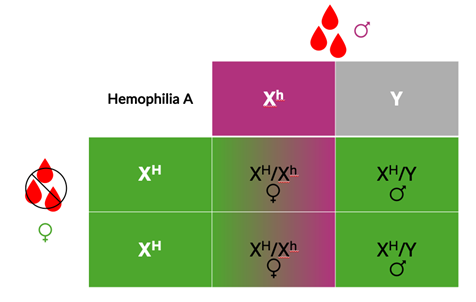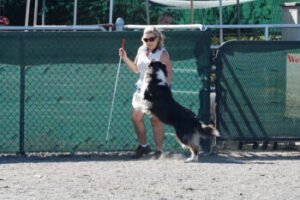by Claire Wiley, VMD, DACVIM (SAIM)
In the world of canine genetics, understanding the principles of inheritance is crucial for breeders aiming to enhance desirable traits and manage hereditary conditions. One important aspect of inheritance that breeders should be aware of is sex-linked inheritance. This article will explain the basic concepts of sex-linked inheritance in dogs, provide examples, and discuss implications for breeding practices.
What is Sex-Linked Inheritance?
Sex-linked inheritance refers to traits that are determined by genes located on the sex chromosomes. In dogs, as in many mammals, there are two sex chromosomes: X and Y. Males have one of each (XY), while females have two X chromosomes (XX). Because of this difference, the way traits are inherited can vary between the sexes.
X-Linked Traits
These are traits carried on the X chromosome. Males, having only one X chromosome, will express whatever allele is present. In contrast, females can be carriers of a trait if they have one affected allele and one normal allele, which means they might not express the trait but can pass it on. Genetic testing is important to help identify carriers and mitigate the disease.
Hemophilia A is an example of a sex-linked trait in dogs, primarily affecting males and inherited in as an X-linked recessive trait. This genetic disorder impairs blood clotting, making affected dogs prone to excessive bleeding. A genetic variant in the F8 gene on the X chromosome leads a deficiency in the coagulation factor VIII (FVIII) protein or a dysfunctional version of the protein. This protein plays a crucial role in the blood clotting process. FVIII is essential for the coagulation cascade, a series of complex biochemical events that lead to blood clot formation. When a blood vessel is injured, FVIII acts as a cofactor for factor IX, which is activated to factor IXa. This activation ultimately leads to the conversion of factor X to Xa, a key step in forming a stable blood clot.
Dogs with Hemophilia A may exhibit symptoms such as:
-
-
- Prolonged bleeding from minor wounds
- Spontaneous bleeding (e.g., in the joints, gums, or skin)
- Bruising
- Hematomas (swelling filled with blood)
-
Inheritance Patterns
When demonstrating inheritance patterns, it is important to distinguish males from females.
- Males (XY): Males inherit one X chromosome from their mother and one Y chromosome from their father. If they inherit an X chromosome with the genetic variant associated with Hemophilia A (Xh), they will exhibit the clinical signs of Hemophilia A since they do not have a second X chromosome to provide a normal allele.
- Normal: XH/ Y
- Affected: Xh/ Y
- Females (XX): Females have two X chromosomes. They can be:
- Homozygous Normal: XH/ XH Normal (not affected and not a carrier).
- Heterozygous: XH/ Xh
- This genotype is a carrier, but does not have Hemophilia A. This dam can pass on the genetic variant for Hemophilia A to their offspring.
- Homozygous Affected: Xh/ Xh
Based on the above genotypes, possible breeding pairs are listed below.
- Normal sire (XH/ Y) x Normal dam XH/ XH
- All puppies will not have Hemophilia A and will not be carriers.

- All puppies will not have Hemophilia A and will not be carriers.
- Normal sire (XH/ Y) x Heterozygous dam (carrier) XH/ Xh
- This combination is the most common way that Hemophilia A is perpetuated, because each of the parents are normal. Breeders do not know if a female is a carrier without genetic testing or family history.
- Each female puppy has a 50% likelihood of being a carrier and 50% likelihood of being normal.
- Each male puppy has a 50% chance of being affected with Hemophilia A and a 50% chance of being normal.

- Affected sire (Xh/ Y) x Normal dam XH/ XH
- Interestingly, breeding a male with Hemophilia A produces all normal puppies. However, all females will pass on the genetic variant associated with Hemophilia A to their offspring.

- Interestingly, breeding a male with Hemophilia A produces all normal puppies. However, all females will pass on the genetic variant associated with Hemophilia A to their offspring.
- Affected sire (Xh/ Y) x Heterozygous (carrier) dam XH/ Xh
- In this scenario, each female puppy has a 50% likelihood of being affected with Hemophilia A, and a 50% likelihood of being a carrier.
- Each male has a 50% likelihood of having Hemophilia A and a 50% likelihood of being normal.

- Normal sire (XH/ Y) x Affected dam Xh/ Xh
- All female puppies will be carriers and can pass on Hemophilia A to their offspring.
- All males will have Hemophilia A.

- Affected sire (Xh/ Y) x Affected dam Xh/ Xh
- All puppies will have Hemophilia A.

- All puppies will have Hemophilia A.
Understanding the mechanism of action for Hemophilia A is vital for breeders to make informed decisions and manage breeding practices effectively. Genetic testing and careful selection of breeding pairs can help reduce the incidence of this condition in future generations.
Implications for Breeding
Understanding sex-linked inheritance can greatly impact breeding decisions. Here are a few strategies breeders can employ:
- Genetic Testing: Breeders should consider genetic testing for known sex-linked traits to identify carriers and affected individuals. This practice can help manage the risk of undesirable traits in future litters.
- Breeding Strategies: When breeding affected males, breeders should be cautious about selecting mates. Since affected males can only pass the Y chromosome to their sons, it is essential to consider the genetic background of potential mates, especially females who may carry recessive alleles.
- Educating Buyers: Responsible breeders should inform puppy buyers about potential inherited traits in their puppies, especially if they are at risk for sex-linked conditions. Transparency builds trust and promotes responsible pet ownership.
- Maintaining Genetic Diversity: Breeders should also aim to maintain genetic diversity in their breeding programs. This approach can reduce the risk of inherited health issues, including sex-linked disorders.
Conclusion
Sex-linked inheritance is a significant aspect of genetics that dog breeders need to understand to make informed breeding decisions. By recognizing how traits are passed down through the X and Y chromosomes, breeders can better manage genetic health and improve the quality of their breeding programs. By utilizing tools like genetic testing and careful planning, breeders can contribute to healthier dog populations while preserving desirable traits.
The AKC DNA Program offers genetic testing for Hemophilia A and other conditions. If you have more questions about how to interpret genetic testing or about which genetic tests are recommended for your dog, please contact the AKC Canine Genetic Counselors by emailing dnahealth@akc.org or calling 919-816-3508 and press 4.
The post Understanding Sex-Linked Inheritance in Dogs: A Guide for Breeders appeared first on American Kennel Club.
Visit American Kennel Club at https://www.akc.org/expert-advice/dog-breeding/understanding-sex-linked-inheritance-dogs-guide-breeders/







